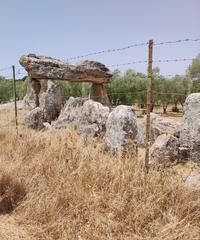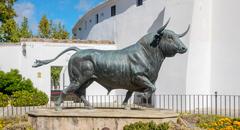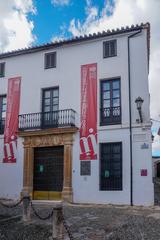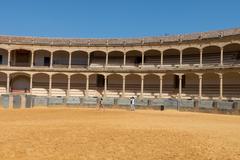Visiting the Ancient Roman Thermae of Acinipo in Ronda, Spain: Tickets, Hours, and Tips
Date: 03/07/2025
Introduction
Perched atop a striking limestone plateau near the celebrated city of Ronda in Málaga, Spain, the Ancient Roman Thermae of Acinipo form one of the most evocative windows into Roman life on the Iberian Peninsula. Established as a settlement for veterans of Julius Caesar’s legions in the 1st century BCE, Acinipo rose to prominence with its sophisticated urban layout, monumental theatre, and a remarkable public bath complex. Today, visitors can explore these well-preserved ruins, marvel at the ingenuity of Roman engineering, and soak in panoramic views of the Andalusian countryside. This guide offers a comprehensive overview of Acinipo’s history, practical visiting information, and essential tips for experiencing one of Spain’s most captivating archaeological sites (Andalucia.com; Junta de Andalucía; Malaga.es).
Contents
- Historical Background of Acinipo
- Prehistoric and Early Settlement
- Roman Foundation and Urban Development
- Economic and Strategic Importance
- Social and Cultural Life
- Decline and Legacy
- The Roman Thermae of Acinipo
- Architectural Features and Archaeological Significance
- Cultural and Social Importance
- The Roman Theatre and Additional Urban Features
- Theatre
- Forum and Urban Layout
- Residential Quarters
- City Walls and Defenses
- Necropolis and Funerary Monuments
- Water Management Systems
- Visiting Information
- Location and Access
- Visiting Hours and Tickets
- Facilities and Accessibility
- Guided Tours and Photographic Highlights
- Nearby Attractions
- Seasonal Events and Cultural Activities
- Visitor Tips and FAQs
- Conclusion
- Further Reading and Resources
Historical Background of Acinipo
Prehistoric and Early Settlement
Archaeological research shows that the Acinipo plateau was settled long before the Romans, with evidence of habitation stretching back to the Neolithic and Bronze Ages. Excavations have revealed prehistoric huts, craft facilities, and early metallurgy, while the influence of coastal Phoenician colonies introduced advanced building techniques and agriculture (malaga.es). These developments laid the foundation for Acinipo’s later prominence.
Roman Foundation and Urban Development
Acinipo’s emergence as a Roman city is closely tied to the period following the Battle of Munda in 45 BCE. Most scholars agree it was founded as a colony for Caesar’s veterans (wikipedia.org). Its elevated location at 999 meters provided formidable defense and sweeping territorial views (malaga.es).
The city flourished in the 1st and 2nd centuries CE, with the construction of major public buildings such as the theatre and thermae. The forum, temples, and other civic structures reflect a well-organized Roman settlement (malaga.es).
Economic and Strategic Importance
Acinipo’s plateau provided fertile farmland and access to marble, iron, and clay, supporting a thriving local economy and trade. Its location at the crossroads of key Roman roads enabled commercial and cultural exchange, and the discovery of locally minted coins points to a degree of economic autonomy (malaga.es).
Social and Cultural Life
The theatre, baths, and forum were focal points of public life, blending Roman customs with local traditions. Necropolises outside the city walls reveal a mix of Iberian and Roman funerary practices, including cremation and the placement of grave goods (malaga.es).
Decline and Legacy
Acinipo’s decline began in the 3rd century CE, as Ronda (ancient Arunda) gained prominence. Despite its eventual abandonment, Acinipo remains a powerful testament to the region’s Roman heritage, with ongoing archaeological research and cultural events breathing new life into its ancient stones (wikipedia.org; malaga.es).
The Roman Thermae of Acinipo
Architectural Features and Archaeological Significance
The thermae of Acinipo are among the best-preserved elements of the city. Built with local limestone, they featured the classic Roman sequence: frigidarium (cold room), tepidarium (warm room), and caldarium (hot room), all heated by an advanced hypocaust system (Ancient History Encyclopedia). Remnants of marble, mosaics, and underfloor heating pillars are visible, attesting to both the luxury and technological sophistication of Roman public baths (Museo de Ronda).
Cultural and Social Importance
Roman thermae were vital spaces for socializing, relaxation, and even business. At Acinipo, as elsewhere in the empire, the baths played a key role in daily life and the spread of Roman culture throughout Hispania (UNESCO Roman Heritage).
The Roman Theatre and Additional Urban Features
Theatre
The theatre, carved into the limestone hillside, could seat up to 2,000 spectators and remains one of the best-preserved in Andalusia (Andalucia.com). Its acoustics and orientation provide a dramatic setting for the occasional modern performance (Turismo de Ronda).
Forum and Urban Layout
Traces of Acinipo’s forum and streets reveal a classic Roman orthogonal plan. Foundations of shops, public buildings, and possible temples surround the forum, illustrating the city’s civic and commercial life (Junta de Andalucía).
Residential Quarters
Remnants of Roman domus, with mosaic floors and hypocausts, reflect the affluence of Acinipo’s inhabitants. Domestic artifacts found here are displayed in the municipal museum of Ronda (Ronda Today).
City Walls and Defenses
Sections of the city’s limestone walls and gates are still visible, underscoring Acinipo’s strategic importance and defensive priorities (Málaga Turismo).
Necropolis and Funerary Monuments
Several necropolises outside the city boundaries contain rock-cut tombs, funerary stelae, and grave goods, providing insight into burial customs and social hierarchy (Turismo de Andalucía).
Water Management Systems
Ingenious Roman cisterns, wells, and channels ensured a steady water supply for the baths and city residents (Ronda Turismo).
Visiting Information
Location and Access
Acinipo is located about 20 km northwest of Ronda and is accessible by car via the A-374 and MA-7401 roads (Krista the Explorer). Free parking is available at the site entrance (Andalucia Lovers).
Visiting Hours and Tickets
- Hours: Wednesday–Sunday, 09:00–14:30 (last entry 45 minutes before closing). Closed Mondays and Tuesdays. Seasonal variations may apply—check the official Acinipo Facebook page for updates (Travel Choreography).
- Admission: Free of charge; no advance booking required.
Facilities and Accessibility
- Visitor Center: Small office at the entrance with basic information. Bilingual (Spanish/English) interpretive panels throughout.
- Restrooms: Available at the entrance only (Krista the Explorer).
- Accessibility: Gravel paths and moderate inclines; limited accessibility for wheelchairs or visitors with mobility issues (Spanish Plains). Sturdy footwear recommended.
Guided Tours and Photographic Highlights
- Tours: Self-guided exploration is standard; local tour operators may arrange guided visits (Krista the Explorer).
- Photography: The theatre and plateau offer spectacular views, especially in the morning.
Visitor Tips
- Best Time to Visit: Spring and autumn offer mild weather; mornings are best in summer due to heat (Andalucia Lovers).
- What to Bring: Water, sun protection, sturdy shoes, and a camera.
- Etiquette: Stay on marked paths, do not climb on ruins, and respect conservation efforts.
Nearby Attractions
Combine your Acinipo visit with Ronda’s Puente Nuevo, bullring, and white villages like Setenil de las Bodegas for a broader Andalusian experience (Andalucia in My Pocket).
Seasonal Events and Cultural Activities
Acinipo’s Roman theatre occasionally hosts open-air concerts and reenactments in summer (Ronda Today). Educational workshops are also scheduled periodically.
Frequently Asked Questions (FAQ)
Q: What are Acinipo’s visiting hours?
A: Wednesday–Sunday, 09:00–14:30; closed Mondays and Tuesdays.
Q: Is admission free?
A: Yes, entry is free for all visitors.
Q: Are guided tours available?
A: Not regularly, but local operators may arrange tours.
Q: Is the site accessible for visitors with mobility issues?
A: Accessibility is limited due to uneven terrain.
Q: Are there on-site facilities?
A: Restrooms at the entrance; no cafes or shops.
Q: Can I combine Acinipo with other attractions?
A: Yes, Ronda and other villages are nearby and easily accessible.
Visual Highlights
 Alt text: Roman Theatre at Acinipo archaeological site, Ronda’s historic Roman ruins
Alt text: Roman Theatre at Acinipo archaeological site, Ronda’s historic Roman ruins
 Alt text: Panoramic view from Acinipo archaeological site over the Ronda Depression
Alt text: Panoramic view from Acinipo archaeological site over the Ronda Depression
Conclusion
The Ancient Roman Thermae of Acinipo, together with its theatre and urban remains, provide a vivid journey into the heart of Roman Andalusia. Free to enter and set amid breathtaking scenery, Acinipo is a must-see for history enthusiasts and travelers alike. Prepare with sturdy shoes, sun protection, and curiosity for a tranquil yet enriching experience. For up-to-date hours and event details, consult official sources and consider using tools like the Audiala app to enhance your visit (Junta de Andalucía; Malaga.es; Andalucia.com).
Sources and Further Reading
- Acinipo Archaeological Site – Málaga Provincial Council
- Acinipo – Wikipedia
- Andalucia.com: Acinipo Roman Ruins
- Junta de Andalucía: Acinipo Archaeological Site
- Museo de Ronda: Acinipo Collection
- Roman Baths Explained – Ancient History Encyclopedia
- Turismo de Ronda: Acinipo Archaeological Site
- Andalucia Lovers: Ruins of Acinipo
- Travel Choreography: Ruins of Acinipo
- Krista the Explorer: Visiting Roman Ruins Acinipo



